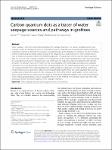Search
Author
- Cui, Kai (1)
- Li, Xingyue (1)
- Ma, Fenyan (1)
- Zhang, Huyuan (1)
- next >
Subject
- Carbon quantum dots (1)
- cyclic process (1)
- grottoes (1)
- XRD test results (1)
- next >
Date issued
- 2023 (2)
Has File(s)
- true (2)
Search Results
Changes in precipitation, temperature and humidity can lead to the weathering of rock masses in grottoes; these changes are common in sandstone grottoes. To simulate this cyclic process, different salt solutions were designed according to the main precipitated components. Sandstone specimens taken from Longshan Grottoes were soaked in these solutions for 48 h and then placed in a simulated environment with temperature and humidity changes for 5 cycles (50 h) to study the effects of hydrochemical, temperature and humidity changes on the sandstone. Physical indexes, such as mass, wave velocity, surface hardness and tensile strength, of the rock samples were measured every three cycles, and the damage characteristics and mechanisms of the sandstone were discussed based on SEM and XRD t... |
Water seepage is one of the main factors leading to the damage of grottoes. The sources and pathways of water seepage need to be identified to relieve it. Although the sources and pathways are investigated using geophysical exploration methods commonly, the results are unsatisfactory due to the limitation of resolution. The tracer method has been widely used to examine water seepage in the natural sciences and engineering. However, most tracers have an impact on grottoes, making this method inapplicable. This study was the first to use the carbon quantum dots as a tracer of water seepage in grottoes. The characteristics of the carbon quantum dots, which was synthesized by various biomass precursors through large-scale synthesis in the field, were analyzed to determine the optimal pr... |


